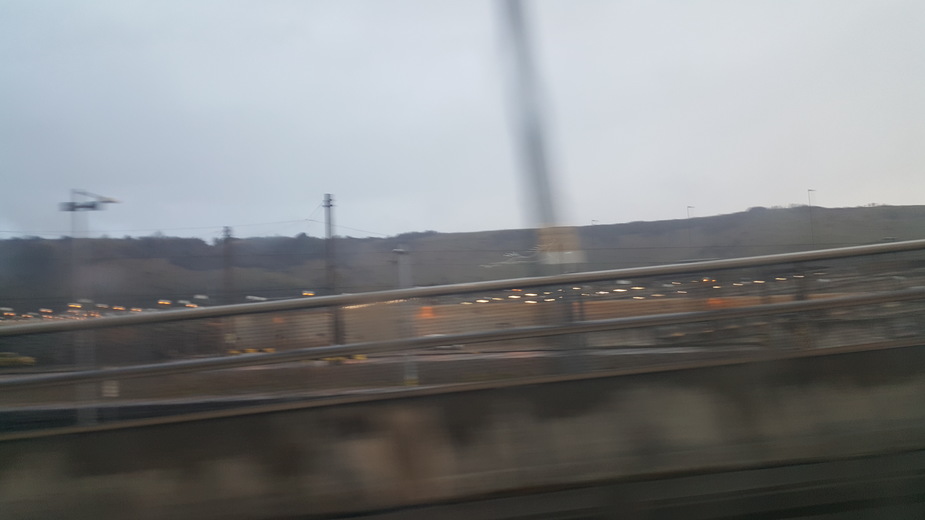I’ve recently been looking for interesting local flights for both currency and engine health. Back in 2016 I’d also been looking for interesting local flights, but to do with my wife for an hour or so after work. After googling local landmarks I decided to go look at the Uffington White Horse, then found there were a total of 9 white horses, 8 concentrated in Wiltshire with Uffington set apart in Oxfordshire. The flight back then took a bit of planning, finding the horses in google maps then copying the locations into Skydemon. Google maps also made it easier to eventually find the horses from the air, in relative location to the town, plus the orientation of the horse shows which side of the hill it’s on. The flight went well, and I’d recommend it for taking passengers as they can enjoy spotting the horses and taking photos.
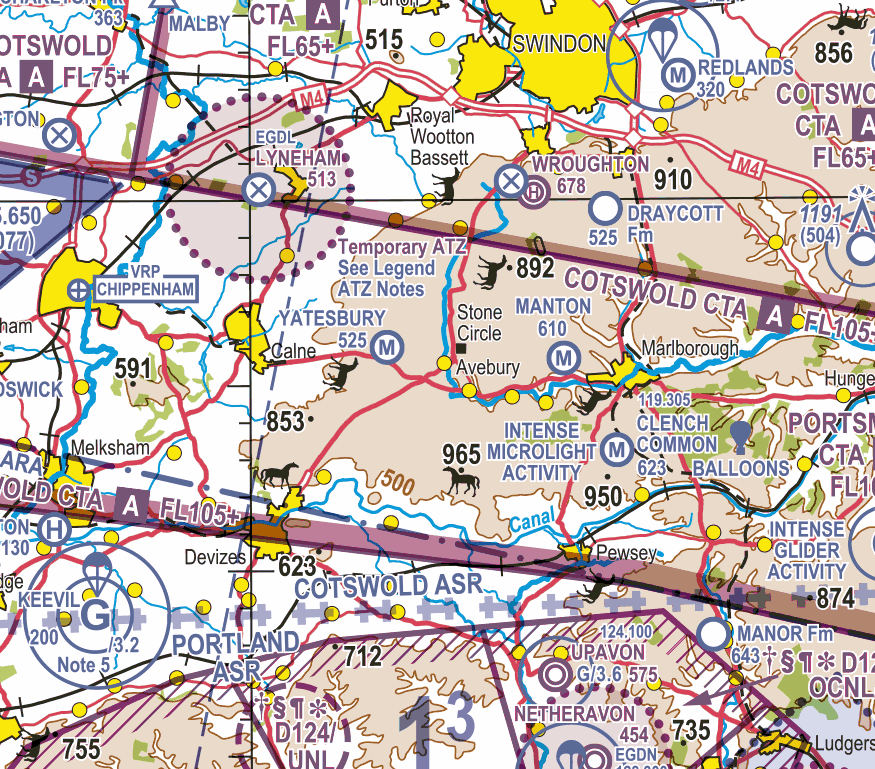
The CAA map showing the horses, Uffington top right, Westbury bottom left, the remaining 7 in the middle. In the centre is Avebury, a Neolithic stone circle (think Stonehenge but more spread out) and Silbury Hill (a prehistoric man-made chalk mound).

Screenshot of the Skydemon route from 2016. I added google maps pictures of the horses at the time to show someone.
Background
Wiltshire has 8 (historically 13) white horses, made by cutting away the grass on a steep hill to expose the chalk below, making the design visible for long distances. The original is the Uffington white horse from 3,000 years ago, and all the others date from the last 250 years. They need regular cleaning, or scouring, otherwise grass grows through the chalk and they eventually disappear. They were covered in WW2 to stop the Luftwaffe using them for navigation… but I’m a bit sceptical as to how effective this would have been considering the trouble I took to find them.
What I found particularly impressive is these were made without being able to look from above. This website has good photos and shows them on a map https://www.thesilvernomad.co.uk/8-white-chalk-horses-in-wiltshire/ and this one has background information http://wiltshirewhitehorses.org.uk/
The day of the flight forecast FEW015 and SCT023, then developing into severe CAVOK. No NOTAMS except possibly some paragliders.
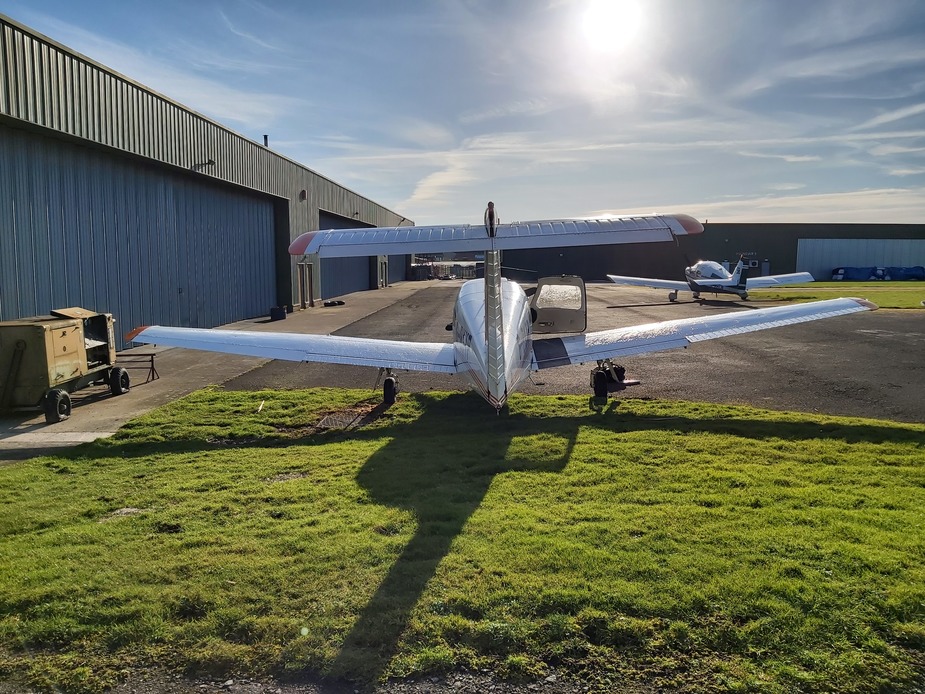
The aircraft: PA-28RT-201
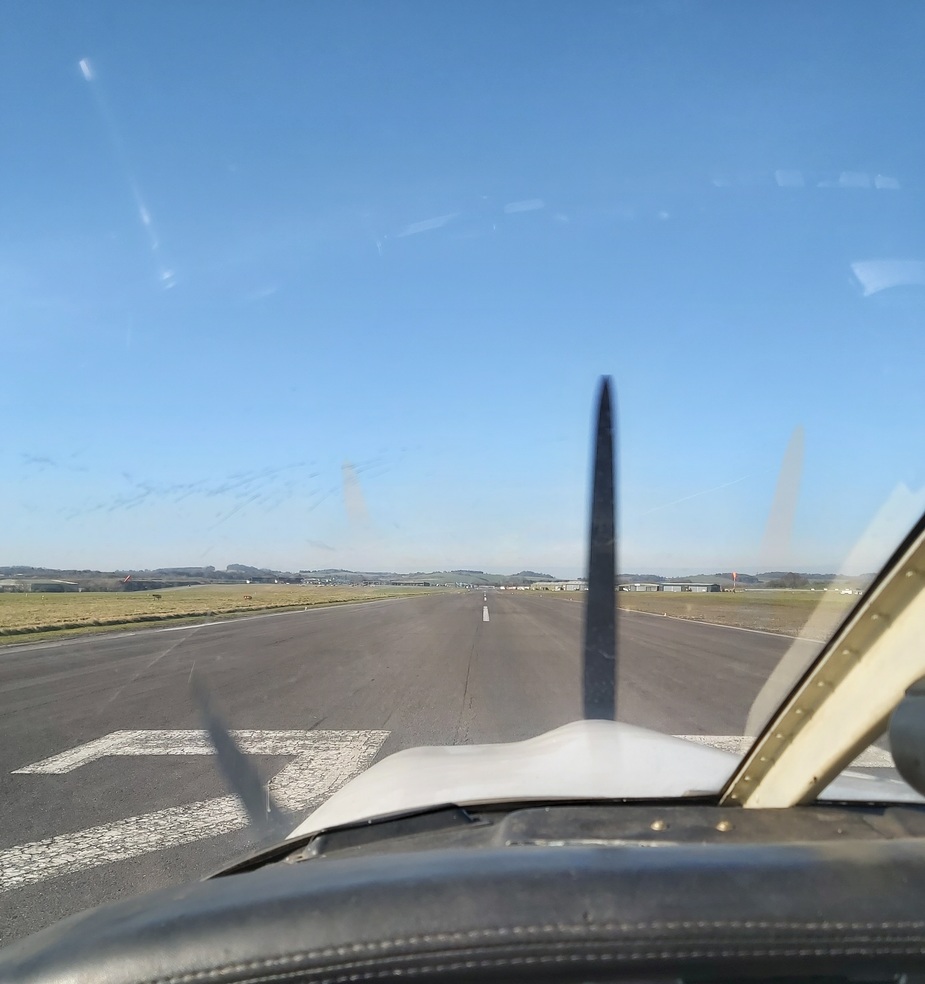
The airfield: aligned RWY25 Thruxton EGHO
Backtrack and takeoff on 25, then an abbreviated circuit and downwind departure to the north west to find the first horse. Flying much lower than normal at 1,500ft made navigating much harder, and I had to rely on the gps. Finding the town of Pewsey wasn’t too difficult, but finding the horse would probably have been near-impossible (just ahead of the leading edge). Unfortunately it was also slightly hazy, which didn’t help. We’ve been to this one by car before, parking on a little side road and walking. Being on a steep hill you get good views, but the horse itself is a bit disappointing: you need to be at a bit of a distance to appreciate it. It was cut in 1937 to replace a previous horse from 1785 that has been overgrown.
Pewsey N511916 W0014524
Alton Barnes, the next horse, 5nm to the north west. No trouble finding this one. It was cut in 1812 and is based upon the Cherhill horse. It has twice had zebra stripes for April Fools  https://www.gazetteandherald.co.uk/news/11125290.april-fool-pranksters-turn-alton-barnes-horse-into-zebra/
https://www.gazetteandherald.co.uk/news/11125290.april-fool-pranksters-turn-alton-barnes-horse-into-zebra/
Alton Barnes N512221 W0015053
Next, along the top of Salisbury Plain to Westbury. One of the most distinctive with a large area of white chalk, but not a very good photo (directly above the wingtip, just below the ridge in the shade). The Westbury, or Bratton, white horse is one of the oldest, next to an iron age hillfort. It was restored in 1778, and there might have once been another facing the other way.
Westbury N511549 W0020849
A 180 degree turn to turn back towards Devizes, which was surrounded by puffy bits of cloud. The Devizes Millennium horse was cut in 1999, based on the nearby Snobs horse which has nigh disappeared. ‘Snobs’ was local dialect for ‘shoemakers’, who originally created it. The new one was reversed from the original, and is the only Wiltshire horse to face right.
Devizes N512235 W0015842
The Lansdowne monument makes it easy to find, but the Cherhill horse is buried in a fold in the ridge and needed an orbit to spot. It’s sometimes called the Oldbury horse after the nearby earthworks/castle. It’s one of the oldest modern horses, predating the first recorded reference from 1742.
Cherhill N512531 W0015548
Broad Town horse was hard to find too, a smaller horse overshadowed by a line of trees. It’s also known as the ‘secret’ horse because it’s a long way from roads and only accessible after a long walk.
Broad Town N513012 W0015133
Little is known about the Hackpen or Broad Hinton horse, but it might have been made for the coronation of Queen Victoria. It’s on a shallow slope so better appreciated from the air, rather than from the ground.
Hackpen N512820 W0014903
The last of the Wiltshire white horses is Marlborough, or Preshute. It’s the smallest horse, on a not very steep hill, and close to the town, making it difficult to spot from the air. Even knowing it was near the athletics track I had to orbit to find it. It was first cut in 1804 by local schoolboys. The round hill with four trees in front of the wing is Marlborough Mound, a Neolithic monument. Marlborough is a nice provincial town to visit, and the high street is one of the widest in the country.
Marlborough N512445 W0014410
Lastly, Uffington. Not in Wiltshire, but Oxfordshire (and historically Berkshire), vertically just above the wingtip. Uffington castle, an iron age hillfort, is apparent in the background. Rather than just removing the grass, it’s actually deep trenches filled with chalk, and is up to 3,000 years old. There’s no good views of it from nearby, and is best viewed from the air. We visited a few years ago and all I remember is there was lots of sheep poo 
Uffington N513443 W0013355
It doesn’t really look like a horse, but I think it really captures the essence of a horse. It originally could have been any animal, but has been called a horse since at least the 11th century, and is similar to horses found on pre-Roman Celtic coins.
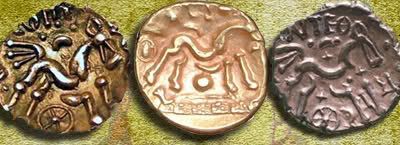
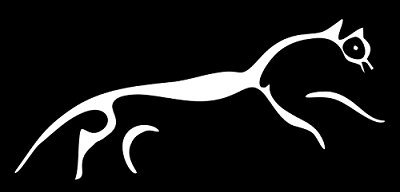
It’s had riders added a couple of times:
http://news.bbc.co.uk/1/hi/england/2220725.stm
https://www.bbc.co.uk/news/uk-england-oxfordshire-17297495
Conclusion
After Uffington I flew to the CPT VOR to lengthen the flight.
It was much harder this time compared to 2016, which can be seen comparing the two Skydemon printscreens. I hadn’t looked at google maps before, so it took longer to spot each horse. Also, it was a bit hazy and one horse was obscured by cloud. Solo, it was harder to fly and take photos at the same time: I did try with the autopilot, but found it harder to take the photos in turns. In the end, I just took about 10 photos of each, and chose the best. For proper photos you’d need another pilot in the right hand seat and to use a zoom lens through the storm window, and maybe a slower plane.
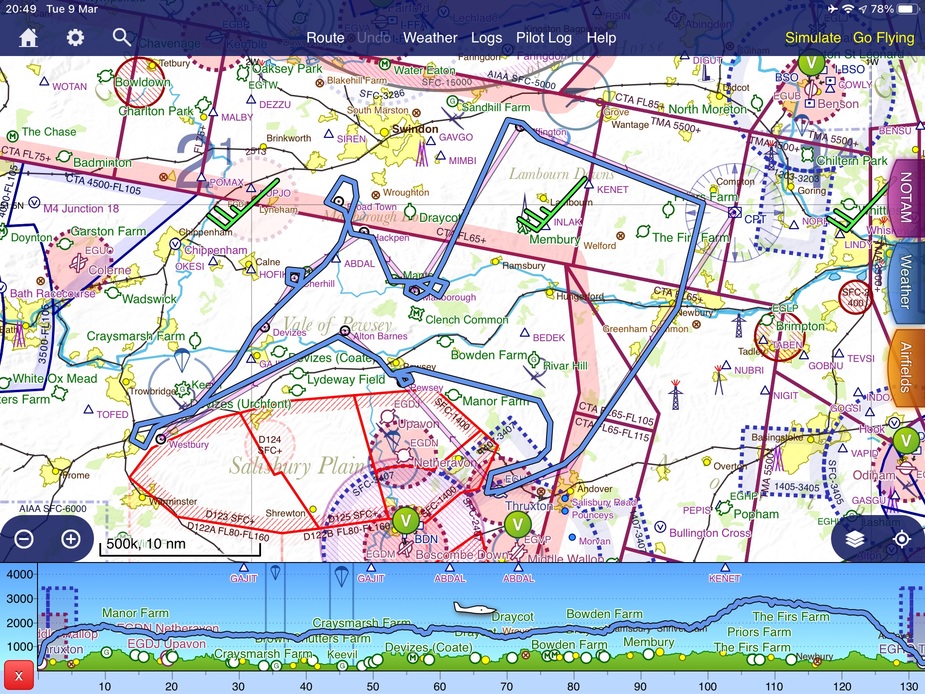
Other hill figures: (mostly from google maps)
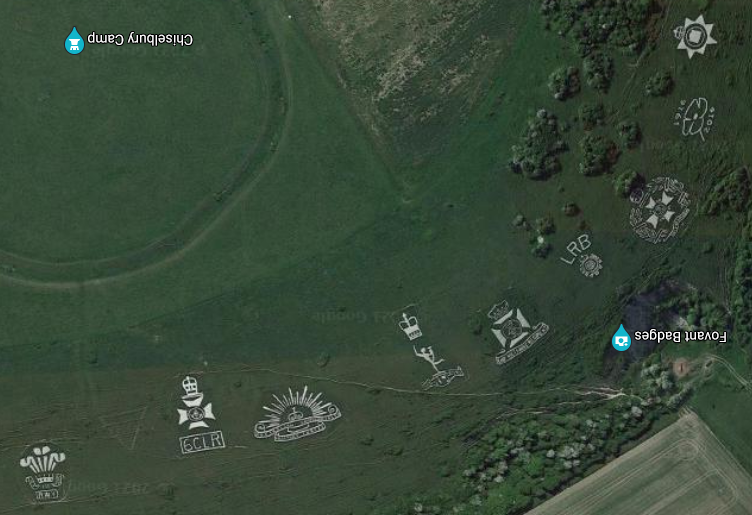
Nearby, the Fovant regimental badges dating from WW1.
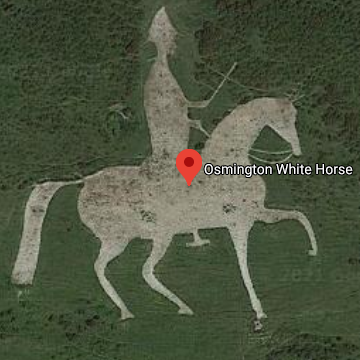
In Dorset, the Osmington white horse
Cerne Abbas Giant, or Rude Man, also in Dorset (zoom in) 

The Litlington white horse in Sussex
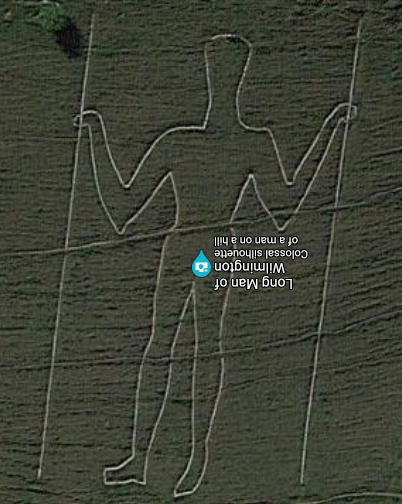
The Long Man of Wilmington also in Sussex. I used to regularly drive past this as a kid.
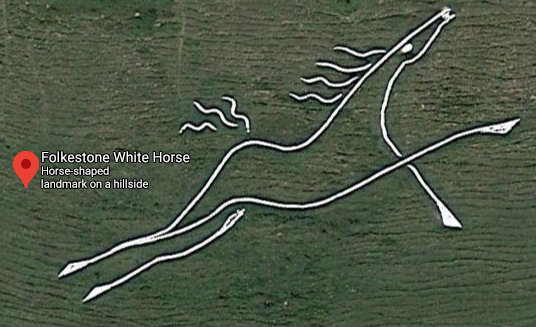
There’s also the Folkestone white horse in Kent, which can be seen from the Channel Tunnel.
There’s a few more around England, but mostly in the south: full list and photos on Wikipedia https://en.wikipedia.org/wiki/Hill_figure
Fantastic! There’s another white horse somewhere in Kent, near the village of Brook.
I was working near there and asked the client if it was very old. Oh yes, she said. Very old. At least the 1960s. 
Love it Capitaine, what a great idea to hunt after !
Mrs was asking for this tour in Wiltshire, but I will substitue with horses 
I wonder how much maintenance these white figures need? I think they are mostly made in chalk hills. Most are centuries old…
You could advertise and make a little business of that one. It’s really an exotic and cool phenomenon.
Ibra wrote:
http://www.ukcropcircles.co.uk/
Thanks Ibra, good find. I went looking for a crop circle a few years ago and it was impossible.
Peter wrote:
I wonder how much maintenance these white figures need?
Historically the maintenance was the responsibility of the landowner. Up to the 19th century the Uffington horse had a fair every seven years to do the cleaning, but it led to drunkenness and debauchery and falling down the hill  Nowadays it’s done by volunteers organised by the local council or National Trust: you’re given a bucket of lumps of chalk and hammer, then spend an hour breaking the chalk and chatting to other people. Actually sounds quite relaxing. Some are looked after by the army, e.g. the Fovant badges, and the Bulford Kiwi used to be looked after by the Kiwi shoe polish company because of the advertising benefits.
Nowadays it’s done by volunteers organised by the local council or National Trust: you’re given a bucket of lumps of chalk and hammer, then spend an hour breaking the chalk and chatting to other people. Actually sounds quite relaxing. Some are looked after by the army, e.g. the Fovant badges, and the Bulford Kiwi used to be looked after by the Kiwi shoe polish company because of the advertising benefits.
LeSving wrote:
You could advertise
Just found a couple:
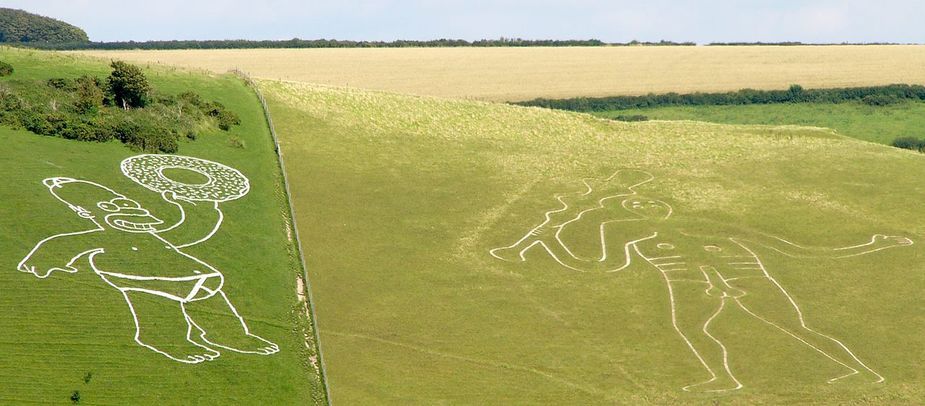
Simpsons movie
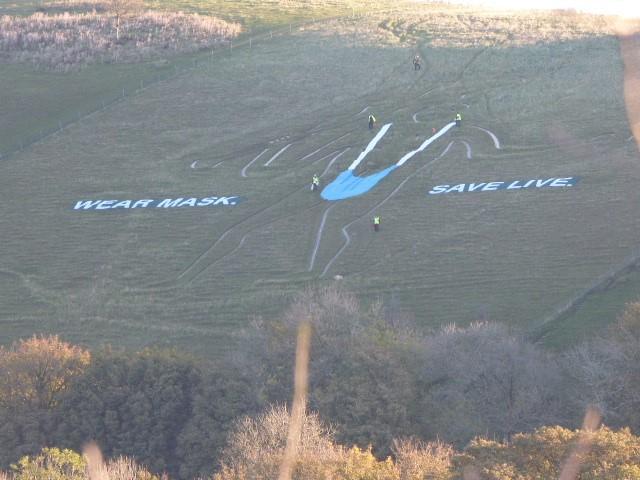
Borat 2
Debauchery sounds interesting… an idea for our next fly-in?
Capitaine wrote:
I went looking for a crop circle a few years ago and it was impossible.
Try with this next time !

Sorry for quality Capitaine but I saw a white horse while exiting the Eurotunnel, a bit fast for my phone to get stable picture, not sure if an Arrow can cope with Qashqai on speeds 
